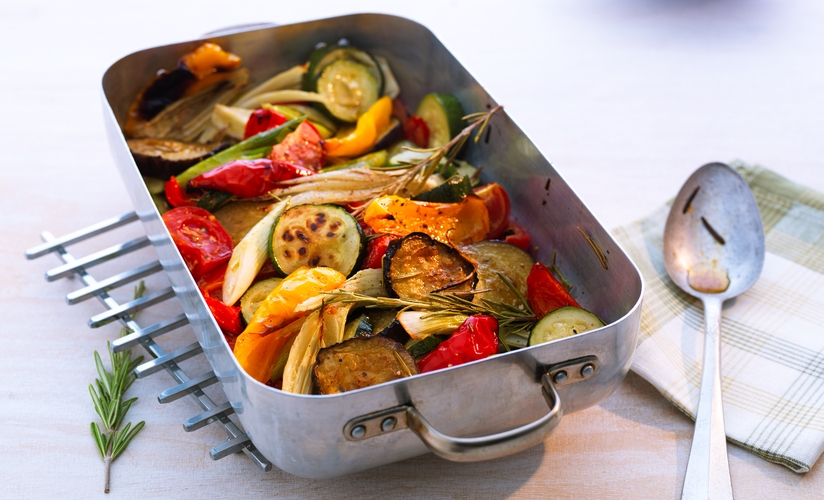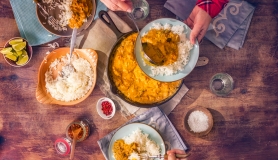PIDE TURKISH PIZZA BREAD
Pide is an exciting bread: soft and chewy, made with yoghurt, and traditionally shaped with a slight hollow that can accommodate any number of fillings
For 2 medium loaves: 7g/¼oz sachet dried yeast, or ½oz/15g fresh ½ teaspoon sugar 200ml/7fl oz/generous ¾ cup tepid water 500g/1lb 2oz/3 1⁄3 cups unbleached plain flour 1 teaspoon salt 2 tablespoons thick yoghurt 2 tablespoons olive oil 1 egg, lightly whisked 1 tablespoon seeds of choice (mustard, nigella, sesame, caraway), optional extra flour and oil, for dusting and greasing
Sprinkle the yeast and the sugar into half the water in a small bowl and leave somewhere warm to interact for 10–15 minutes.
Sift the flour and salt into a big bowl, make a well in the middle, and trickle in the yeast mixture together with the yoghurt, oil and the rest of the water. Beat it with a wooden spoon until it all comes together, and then pop the dough on to a floured board and use your hands to knead and knead and knead – it will need about 10 minutes of your most enthusiastic pounding.
Pour a little oil into the mixing bowl, tipping it so the bottom area is well covered. Roll the dough ball in the oil (to stop it drying out), cover the basin with a damp teatowel or some clingfilm, and leave to prove (as real bakers say) in a warm place for a couple of hours.
Once the dough has doubled in size (more or less), flatten it vigorously with the palms of your hands, and then knead it some more.
Divide it into two balls, and form each one into a pointed oval shape, pinching the edges to form a fat rim – they should look like badly built kayaks. Actually, you can make it any shape you like, but this torpedo shape is the most fun/traditional.
Cover the loaves and set aside for another 20 minutes to rise a little more. Heat the oven to 230˚C/450˚F/Gas mark 8.
Grease a couple of baking trays and pop them into the oven to heat up. Brush the loaves with the egg and sprinkle them with seeds (if using). Slide each one on to one of the piping hot baking trays and cook for 15 minutes, or until golden brown. This bread is best enjoyed fresh – if you want to eat it later in the day, wrap it in foil or a clean kitchen cloth.
* Use this bread like a pizza base – fill with grilled vegetables, halloumi, eggs, biber salçasi ... You can even fill it with fruit and crème patisserie and serve it as cake. This stuff rocks.
SARASURA MIDDLE EASTERN RATATOUILLE What a joy this dish is. A bit of chopping, shove it in the oven, and an hour or so later it is ready: a tender and aromatic composition of the season’s and region’s finest veg. With some garlic bread on the side it makes for a filling main course, although you can also serve it with bulghur wheat or rice. Yes, it does resemble ratatouille, and yes, if you are a vegetarian too much of it can wear thin. But do you know, I reckon it’s due for a comeback. If prawn cocktail, steak and Black Forest gâteau are enjoying a renaissance, then ratatouille and vegetarian lasagne/ moussaka are sure to follow. In Turkey this dish is usually known as türlü, but there are huge regional variations. Briami is the name it goes under in Cyprus. The recipe below should be pretty easy to follow all year round – but do add proportional amounts of seasonal stuff to it: summer peas and beans, okra, artichokes or winter tubers. As a variation, throw some chunks of halloumi into the mix about halfway through the cooking time. Or make a few pot holes and drop a raw egg into each about 20 minutes before you want to serve. This is Kim’s recipe (I think) from Never on a Sunday, the name of a way-ahead-of-its-time taverna where I worked for a wee while. (Also the name of a brilliant film.)
Serves 4 2 aubergines, cut into 3–4cm (1¼–1½in) chunks 2 courgettes, cut into 3–4cm (1¼–1½in) chunks 2 waxy potatoes, peeled and cut into 3–4cm (1¼–1½in) chunks 1 red pepper, cut into 3–4cm (1¼–1½in) chunks 1 green pepper, cut into 3–4cm (1¼–1½in) chunks 1 large onion, peeled and roughly chopped 8 garlic cloves, peeled and bashed 4 tomatoes, quartered 2 teaspoons dried oregano 3 bay leaves salt and black pepper 1 large handful of chopped fresh parsley
Preheat the oven to 180˚C/350˚F/Gas mark 4.
Arrange all the ingredients bar the last two in a sturdy oven tray or casserole, turning gently to mix well.
Add a splash of water: just enough to cover the bottom of the tray. Cover the dish and cook in the oven for 1½ hours, or until the potatoes are cooked and the other vegetables tender.
Strew the parsley across the top just before you dish up. Serve in earthy looking bowls with some interesting bread on the side.
ASURE NOAH’S PUDDING This is simply glorious. And it’s another recipe with a story attached. The tale goes that supplies on the Ark were just about finished when it went aground on Mount Ararat. Hoping to eke out a final repast whilst the flood waters were subsiding, Mrs. Noah literally emptied all of the ship’s stores and cooked it into this – one magnificent, nutritious pudding. To this day in Turkey it is seen as a meal to share, and is usually made by the vat-full. It is consumed during the holy time of Muharram, which is the first month of the Islamic calendar. The name Asure refers to the tenth day of Muharram, which is a day of mourning and reflection, especially for Shi’ia Muslims because it is the day on which Imam Hussayn was martyred. The pudding was originally made with bulghur wheat, but barley is my grain of choice because it cooks so well. This is one of those splendid recipes in which you can substitute ingredients to suit the contents of your pantry. Serves 10
50g/1¾oz/scant ½ cup haricot (navy) beans, and 75g/2¾oz/scant ¾ cup chick peas, and 50g/1¾oz/scant ½ cup kidney beans, and 225g barley (pot barley or pearl barley), all soaked in water overnight 75g/2¾oz/ 1⁄3 cup short grain rice, and 100g/3½oz dried chopped apricots, and 50g/1¾oz/scant 1⁄3 cup raisins, and 50g/1¾oz/scant 1⁄3 cup sultanas, and 50g/1¾oz/ 1/3 cup currants, and 50g/1¾oz/¼ cup dried chopped figs, all soaked in water for 30 minutes 50g/1¾oz/generous ½ cup blanched, chopped almonds 50g/1¾oz/½ cup chopped walnuts 450g/1lb/2¼ cups sugar, 1 tablespoon cornflour 100ml/3½fl oz/scant ½ cup rose water
To decorate: 2 tablespoons fresh pomegranate 1 tablespoon pine nuts 1 tablespoon nibbed pistachios 5–6 dried apricots, sliced
Cook the beans and chickpeas (about 45 minutes should do it), then drain them.
Place the barley together with the water in which it has been soaking into a big pan, and bring to the boil.
After 15 minutes, add the rice.
After a further 15 minutes, add the cooked beans/peas, and the chopped fruit and nuts.
Allow to cook for another 15 minutes, then add the sugar. Then blend a little of the hot barley water with the cornflour and add this to the pudding, mixing well.
Finally stir in the rose water and, if it is looking too stodgy, dilute with more water or a splash of milk. Let it cook through for a few minutes more, then take off the heat. This is traditionally served cold – but I rather like it hot with a when-no-one’s-lookingdash of cream. Anyway, to be authentic, pour the asure into a bowl, sprinkle with the garnish, and pop it in the fridge to chill.
For more fabulous recipes from the Middle East, check out ‘Veggistan’ by Sally Butcher - tinyurl.com/veggistan






